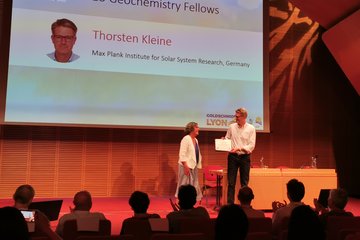Alle Typen
21.
Zeitschriftenartikel
MHD structures, waves and turbulence in the solar wind: Observations and Theories. Space Science Reviews 73, S. 1 - 210 (1995)
22.
Zeitschriftenartikel
Comment on ``Evolution of energy-containing turbulent eddies in the solar wind'' by W. H. Matthaeus, S. Oughton, Pontius, Jr., D. H. and Y. Zhou. Journal Geophysical Research 100, S. 12323 - 12328 (1995)
23.
Zeitschriftenartikel
Non-Gaussian probability distributions of solar wind fluctuations. Annales Geophysicae 12 (12), S. 1127 - 1138 (1994)
24.
Zeitschriftenartikel
On the nature of compressive fluctuations in the solar wind. Journal Geophysical Research 99 (A11), S. 21481 - 21509 (1994)
25.
Zeitschriftenartikel
Modelling results on spatial transport and spectral transfer of solar wind Alfvénic turbulence. Journal Geophysical Research 98, S. 21045 - 21059 (1993)
26.
Zeitschriftenartikel
Correlations between the fluctuations of pressure, density, temperature and magnetic field in the solar wind. Annales Geophysicae 11, S. 659 - 677 (1993)
27.
Zeitschriftenartikel
A model of solar wind fluctuations with two components: Alfvén waves and convective structures. Journal Geophysical Research 98, S. 1257 - 1276 (1993)
28.
Zeitschriftenartikel
A case study of very low cross-helicity fluctuations in the solar wind. Annales Geophysicae 9, S. 319 - 332 (1991)
29.
Zeitschriftenartikel
Temperature fluctuation spectra in the inner solar wind. Annales Geophysicae 9, S. 748 - 753 (1991)
30.
Zeitschriftenartikel
Spectral and spatial evolution of compressible turbulence in the inner solar wind. Journal Geophysical Research 95, S. 11945 - 11956 (1990)
31.
Zeitschriftenartikel
On the radial evolution of MHD turbulence in the inner heliosphere. Journal Geophysical Research 95, S. 8211 - 8229 (1990)
32.
Zeitschriftenartikel
Transfer equations for spectral densities of inhomogeneous MHD turbulence. Journal of Plasma Physics 44, S. 103 - 122 (1990)
33.
Zeitschriftenartikel
Evidence for a ``background'' spectrum of solar wind turbulence in the inner heliosphere. Journal Geophysical Research 95, S. 4337 - 4341 (1990)
34.
Zeitschriftenartikel
The dependence of MHD turbulence spectra on the inner solar wind stream structure near solar minimum. Geophysical Research Letters 17, S. 283 - 286 (1990)
35.
Zeitschriftenartikel
Dynamics of correlation functions with Elsässer variables for inhomogeneous MHD turbulence. Journal of Plasma Physics 41, S. 479 - 491 (1989)
36.
Zeitschriftenartikel
Basic properties of solar wind MHD turbulence near 0.3 AU analysed by means of Elsässer variables. Journal Geophysical Research 94, S. 11739 - 11759 (1989)
37.
Konferenzbeitrag
On cyclotron-wave resonance and ion velocity distributions in coronal holes and the fast solar wind. In: Proceedings of SOHO 11 Symposium ``From Solar Min to Max: Half a Solar Cycle with SOHO'',, S. 395 - 398 (Hg. Wilson, A.). ESA Publ. Div., Noordwijk (2002)
38.
Konferenzbeitrag
Closure of multi-fluid equations for cyclotron-resonant interactions of ions with Alfvén waves in the solar corona. In: Proc. 9th Int. Solar Wind Conf. ``Solar Wind Nine'', Nantucket, MA, USA, 5-9 October 1998, S. 393 - 396 (Hg. Habbal, S.; Esser, R.; Hollweg, J. V.; Isenberg, P. A.). The American Institute of Physics, Woodbury, NY, USA (1999)
39.
Konferenzbeitrag
Study of the heating mechanism of the solar wind ions in coronal holes. In: Proc. 9th Int. Solar Wind Conf. ``Solar Wind Nine'', Nantucket MA, USA, 5-9 October 1998, S. 373 - 376 (Hg. Habbal, S. R.; Esser, R.; Hollweg, J. V.; Isenberg, P. A.). The American Institute of Physics, Woodbury, NY, USA (1999)
40.
Konferenzbeitrag
Bright plumes and dark lanes as observed in Mg X 625 Å and N V 1239 Å in the solar polar corona. In: Proc. Fifth SOHO Workshop ``The Corona and Solar Wind Near Minimum Activity'', Oslo, S. 555 - 560 (Hg. Wilson, A.). ESA Publ. Div., Noordwijk (1997)











